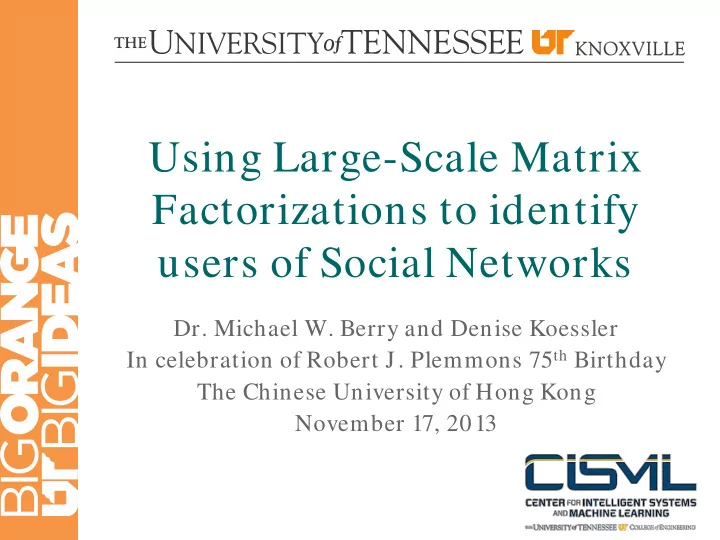

Using Large-Scale Matrix Factorizations to identify users of Social Networks Dr. Michael W. Berry and Denise Koessler In celebration of Robert J. Plemmons 75 th Birthday The Chinese University of Hong Kong November 17, 2013
Percent of total calling behavior observed in four different cities during time t 50.0% 40.0% 30.0% 20.0% 10.0% 0.0% Morning Calls Day Calls Evening Calls Night Calls City A 9.8% 43.5% 32.9% 13.9% City B 10.4% 45.7% 33.2% 10.8% City C 10.3% 45.2% 33.5% 10.9% City D 10.5% 46.9% 32.5% 10.1%
Number of users who spend more than 25% of their total activity during time t 70,000 60,000 50,000 40,000 30,000 20,000 10,000 Call Text Call Text Call Text Call Text 0 Morning Day Evening Night
Is a mobile customer’s mobile behavior unique? Yes Yves et. al, Unique In the Crowd, March 2013, Nature Do we need physical location?
Why is this difficult? ??
Why is this difficult? The actual world…
Research Goal: Given a social network, can we detect key components of user data that uniquely identifies individuals throughout time?
Preliminary Approaches: Social Fingerprinting Goal: Accurately identify social network users Persona based on features of a dynamic, labeled graph Time t
Social Fingerprinting Candidate A Candidate B Persona Candidate C Time t Time t + 1
Statistics for second neighbor graphs: created from one month of history 100% 96.12% Percent of Total Cases Volume for each 80% graph type 60% Percent of graphs 40% containing the 20% correct answer 2.90% 0% 2 6 10 14 18 22 26 30 34 38 42 46 The number of friends in month t for the subscriber of study
Method: Max Friends Candidate A Candidate B Persona Candidate C Time t Time t + 1
Accuracy Max Friends One Month of History 100.00% (10+ Friends in common, 95% Accurate) 80.00% 60.00% 40.00% 20.00% 0.00% 1 4 7 10 13 16 19 22 25 28 31 34 37 40 43 46 49 Number of Friends in Common 12
Need: identification of features Social Network User A Social Network User B
Semidiscrete Decomposition (SDD) [Kolda and O’Leary 1998]
SDD Procedure: 1. Construct matrix A and query vector(s) 2. Semidiscrete Decomposition of matrix A to yield rank- k approximation 3. Compute new query vector 4. Rank the personas wrt cosine similarity 5. Evaluate
Construction: 0 4 1 3 2 Time t
Construction: 0 4 1 3 2 Time t
Construction: Query Vectors 0 4 1 3 2 Time t + 1
SDD of A: k = 3
SDD of A: k = 3
Query Vector Reduction
Similarity between these graphs: 0 0 4 1 4 1 3 2 3 2 Time t Time t + 1
Cosine Similarity: q t+1 [j]*V (t) [i] V[0] V[1] V[2] V[3] V[4] q[0] 0.846 8467 0 0 0.5319 0 q[1] 0.985 9859 0.0704 0.9859 0.1516 0.9859 q[2] 0.977 9778 0.977 9778 0.977 9778 0.2095 0 q[3] 0.969 9693 0.2454 0 0 0 q[4] 0.989 9899 0.989 9899 0.989 9899 0.1414 0
Future work using SDD: 1. An optimal parameter k? 2. Additional similarity measures 3. How often is a persona ranked in the top 1%? 4. When this approach is incorrect, what does the distribution of the correct identity look like? 5. Is there a threshold for inconclusively? 6. Find a confidence factor is there a large separation in scores?
Conclusions We have a triad of issues: Run Time Data Accuracy Volume
Conclusions from a Big Data Perspective : At this point, we are either: Accurate on a small portion of the data on any window of time. Accurate on all of the data given infinite amount of storage space … or … Able to classify volumes of social inferences in real time with low confidence.
References R. Becker, C. Volinsky, and A. Wilks. 2010. Fraud Detection in Telecommunications History and Lessons Learned. In Technom etrics. Vol. 52, No 1. C. Cortes, D. Pregibon, and C. Volinsky. 2001. Communities of Interest. In Proceedings of the 4th International Conference on Advances in Intelligent Data Analysis (IDA '01). Springer-Verlag, London, UK, UK, 105-114. S. Keshav. 2005. Why cell phones will dominate the future internet. SIGCOMM Comput. Commun. Rev. 35, 2 (April 2005), 83-86. DOI=10.1145/ 1064413.1064425 http:/ / doi.acm.org/ 10.1145/ 1064413.1064425. A. Nanavati, S. Gurumurthy, G. Das, D. Chakraborty, K. Dasgupta, S. Mukherjea, and A. Joshi. 2006. On the structural properties of massive telecom call graphs: findings and implications. In Proceedings of the 15th ACM international conference on Inform ation and know ledge m anagem ent (CIKM '06). ACM, New York, NY, USA, 435-444. DOI=10.1145/ 1183614.1183678 http:/ / doi.acm.org/ 10.1145/ 1183614.1183678 J. Onnela, J. Saramaki, J. Hyvonen, G. Szabo, D. Lazer, K. Kaski, J.Kertesz, and A. Barabasi. 2007. Structure and tie strengths in mobile communication networks. In PNAS. Vol 104. No. 18. 7332 – 7336. X. Ying and X. Wu. 2009. On Randomness Measures for Social Networks. In SIAM International Conference on Data Mining. 709 – 720.
Extra slides follow..
Ranking Alternatives: Structure A and q: 1) Persona x Persona 2) Persona x Time 3) Persona x Persona x Time Evaluate SDD Performance Select Ranking Function: 1) Cosine 2) Euclidean 3) Jaccard 4) Pearson
Recommend
More recommend